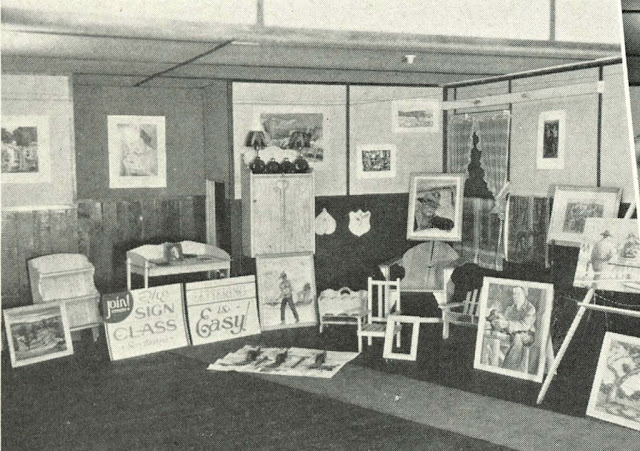All photos below (unless otherwise noted) are from: Civilian Conservation Corps, District No. 3, Third Corps Area, Official Annual, 1937.

Above: Part of Company 1360, Camp NA-1, Washington, DC, ca. 1937. This camp was located at 28th and M Streets, NE (an intersection that no longer exists; more on that later). Company 1360 was originally formed at Fort George G. Meade, Maryland, on June 7, 1933. The company performed its initial work at Camp P-61 (Chester, Virginia), then worked at Camp SP-9 (Williamsburg, Virginia) before settling into Camp NA-1 (originally "Camp NP-11") in the southern area of the National Arboretum, November 1934.

Above: A closer look at some of the enrollees of Company 1360 (from the previous photo). The 1937 CCC Annual reports: "This company has occupied [the National Arboretum] site since November 1, 1934. A person having seen the site prior to this time would not recognize it at present. Roads and walks have been built, tons and tons of top soil have been hauled in to cover the barren clay spots. Grass has been seeded, shrubbery planted. And now the place gives an appearance, in the spring and summer, of a beautiful flower garden."

Above: As can be seen from this partial list of members, most of the young men of Company 1360 came from Washington, D.C. In addition to their National Arboretum activities, Company 1360 also worked at other D.C sites - Fort Mahan, Brentwood Park, Fort Bunker Hill, the C & O Canal, and Rock Creek Park.

Above: Company 1360's band. The man in the trench coat is probably their commanding officer, Captain Alvin T. Wilson, U.S. Army. (Company 1360, like most CCC companies, had several commanding officers during its existence.)

Above: Men of Company 1360 - probably the boxing team. The CCC was a great place for young men to become physically fit with work, recreation, and good meals.

Above: Cooks and kitchen workers for Company 1360, vital to the health and strength of the enrollees.

Above: Music, song, and dance were some of the many possible recreation opportunities for members of Company 1360. Other activities at Camp NA-1 included movies, plays, basketball, swimming, and ping pong.

Above: This is probably an arts and crafts room and/or display for Company 1360. Many of the young men who enrolled in the CCC brought skills with them - carpentry, farming knowledge, musicianship, baseball and other sports, drawing and painting, etc.

Above: Relaxing with a game of cards. In addition to work and recreation, many enrollees in Company 1360 took classes in auto repair, cooking, carpentry, radio, heavy equipment operation, welding, and more. There were also lectures on topics such as engineering and economics.

Above: Where, exactly, was Company 1360's camp NA-1? Is there a wayside marker for it in the Arboretum? (I don't think so, but I'm not 100% sure). Recall that the camp was at 28th and M Streets NE. That intersection does not exist today. However, above is the National Arboretum section of a 1937 WPA map of DC, where I have drawn (on a copy) a line and arrow to the intersection of 28th and M Streets NE. Before you proceed to the next image, make a mental note of the lake (Kingman Lake), and its two upper islands, in relation to M Street.

Above: In this Google Earth aerial view, I have placed a marker (A) where M Street ends today. I have placed another marker (B) on the southern end of the uppermost island in Kingman Lake. Next, I've placed a yellow line where I think 28th Street used to run, north to south. I think Company 1360, Camp NA-1 was somewhere in the vicinity of the white dot you see at the mid-point of the yellow line. However, it could have been further north, for example, closer to the parking lot you see. In the 1937 Annual, we are told: "The camp site, a flat surface extending up to the wooded hills reminds one of a plateau in a mountain range. The tall hardwood trees and high hills to the south makes this a wonderful location for a camp, especially for the summer months." With this textual description, and the map images above, a site visit might lead to the exact location of the camp (again, assuming that the site is not already marked). Image above used for educational and non-commercial purposes.
Company 1360's development of the National Arboretum
In the November 16, 1941 edition of the Sunday Star (Washington, DC), journalist Harold Phillips wrote: "The setting of the stage for [the National Arboretum] has had the assistance of a Civilian Conservation Corps Camp which has been working there since 1934. What was once a rather forlorn area, mostly of scrubby and worn-out truck farmland, heavy underbrush and much deadwood, now is showing the effects of transformation by presenting a picture of truly sylvan beauty" ("Arboreal Paradise Soon Opens to Public Here," p. B-4).
A few days later, writing in the same paper's daily edition (the Evening Star), Frederic A. Delano, chairman of the Advisory Council of the United States National Arboretum (and FDR's uncle), noted: "These competent young men [of the CCC] have, among other things, built roads, laid out trees areas, built artificial lakes and, in fact, have helped put the soil in good condition for growing a tree crop" ("Mr. Delano Outlines Progress of Arboretum," Evening Star, November 19, 1941, p. A-10).
For more information about Company 1360's work and activities at the National Arboretum, see "National Arboretum - Washington DC" (Living New Deal) and "Civilian Conservation Corps Activities in the National Capital Region of the National Park Service" (National Park Service, Historic American Buildings Survey No. DC-858, pp. 33-39 and 135).
In addition to their work at the National Arboretum, African Americans in the CCC worked in many other parks, forests, wildlife refuges, private farms (demonstrating soil conservation methods), and other lands across the nation. Unfortunately, this history has largely been forgotten.




No comments:
Post a Comment